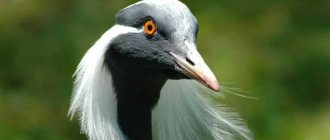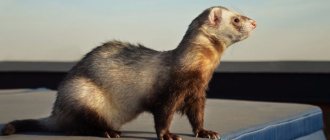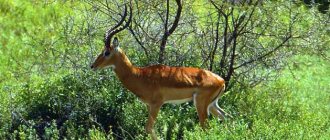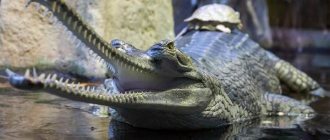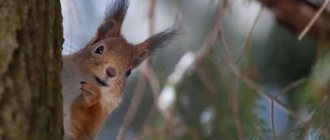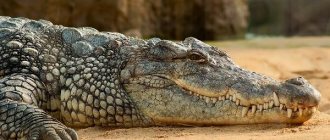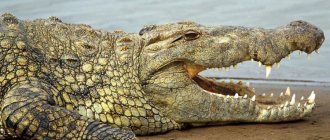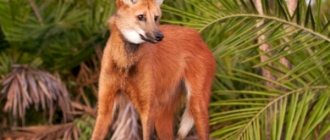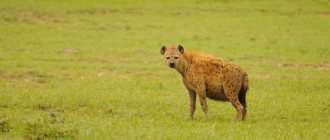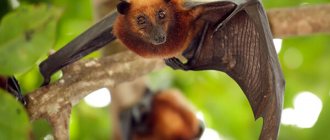Majestic but dangerous reptiles are one of the most ancient inhabitants of planet Earth. During evolution, these reptiles decreased in size, but practically did not change their appearance. As zoologists have found out, their closest relatives are birds. Let's go on a trip to their habitats, and our review presents the most unusual and beautiful species of crocodiles.
The most unusual and amazingly beautiful species of crocodiles:
1
Black Caiman / Melanosuchus niger
According to the classification, the large Amazonian crocodile belongs to the large alligator family, but is classified as a separate species. Today, its habitat is limited to the Amazon with its extensive tributaries.
The scaly skin has a dark color, which is why the dangerous resident of South America got its name. On average, black caimans grow up to 4.6 m. But in nature there were males whose length reached more than 5 m.
In recent decades, their population has begun to decline sharply. The reason is the actions of poachers. The population is affected by deforestation of tropical forests and drainage of wetlands. There have been recorded cases of attacks on people that resulted in the death of a person. But due to the remoteness of the habitats of this species of caimans, attacks occur infrequently.
By the way, on our website most-beauty.ru there is an interesting article about the TOP 13 deadliest animals in the world.
2
Sharp-snouted crocodile / Crocodylus acutus
Based on its habitat, it is also called American, since this species is widely distributed in North, Central and Latin America. It was first described in 1807 by the French naturalist Georges Cuvier.
For life it chooses mangrove swamps, thickets of river mouths, and salty freshwater reservoirs. On land they move at speeds of up to 16 km/h, and in bodies of water they move at speeds of up to 32 km/h. The length of adult males reaches 4 meters, females are slightly smaller, no more than 3.5 meters.
Due to the demand for leather at the beginning of the twentieth century, this species was massively destroyed. The number of individuals has now been stabilized, giving the species protected status. This made it possible to punish hunters for valuable skins.
3
Social structure and reproduction
Nile crocodiles live in one place and gather in groups only when they hunt large prey, which they then eat together. There are no fights because the community has a hierarchy. I am dominated by large individuals, which drive away their smaller counterparts from prey and females.
Most of the details of the behavior of these reptiles have been studied, but some aspects have been little studied.
At about 10 years of age, crocodiles reach sexual maturity. By this time, their length reaches about 3 meters in males and 2.5 meters in females. The timing of the mating season depends on living conditions. In Africa, this is the end of the year when the rainy season begins, and in northern latitudes the period falls in summer.
At this time, males, in order to attract the attention of females, snort and hit the water with their muzzles, making a roar. Females also slap the water, but with their tails.
They observe and choose the strongest and largest partner. When an animal is chosen for procreation, the defeated males admit defeat and quickly swim away, giving way to a competitor. If it is not possible to escape, the loser admits defeat by raising his muzzle up. The winner can grab him by the paw, but will not bite him.
The couple begins mating games: crocodiles rub the underside of their muzzles against each other. At the same time, both make peculiar sounds characteristic of the mating period. The mating process takes place underwater. Its duration is 1-2 minutes. After 2 months, the female is ready to lay eggs. To do this, she digs a hole 50 cm deep in the coastal sand. There she lays 55-60 eggs, which resemble chicken eggs in shape and size.
She sprinkles them with sand and protects them for 3 months, never leaving the masonry. The male is also nearby, helping the female protect the offspring from possible enemies. Reptiles are very aggressive at this time, so they give a serious rebuff to anyone who approaches the clutch.
However, many crocodiles are not destined to be born. For various reasons, they die inside the eggs, and nests are also destroyed by mongooses, hyenas and people. Only 10% of the total number of reptiles hatch into the world.
They pierce the shell themselves, using a hard growth on the muzzle, or with the help of parents, who take the egg, from which the baby cannot get out, into the mouth, holding it with the tongue and palate, and lightly squeeze it. The young hatched on their own make a sound similar to the chirping of birds, which attracts the mother.
She digs up the nest and helps the babies get to the shallow water chosen in advance. Here the cubs, which are only 30 cm long, will live and grow up. This is how the mother shows them the way and at the same time protects them from predators who really like young reptiles. Those babies who cannot make it to the water on their own are carried by the mother in her mouth.
Babies grow quickly, but their mother continues to protect them until they are 2 years old. If several female crocodile nests nearby, then they look after the offspring together. The kids seem to “go” to a crocodile kindergarten. After this, the young animals are expelled. Lonely reptiles wander, trying to avoid encounters with adult crocodiles. They return to their native shore after reaching puberty.
It has already been said that the sex of the babies is determined by the temperature in the nest, and not by genetics. Males appear where the temperature was 31.7-32.5 degrees. At higher temperatures, the eggs will hatch into females.
Breeding
To breed in captivity, crocodiles need a spacious terrarium with enough vegetation and a heated island where they can restore their body temperature. It is also necessary to prepare a place with a substrate - a mixture of peat, moss, shavings. The female will lay eggs in it. There must be water under the substrate, i.e. it must be hygroscopic so that the embryos receive a sufficient amount of moisture from the air and soil.
In order for individuals who have reached sexual maturity to pay attention to each other, it is recommended to keep the relish separately until the start of the mating season. If a female is placed with a pair of males, the latter may start a fight and injure each other.
You also need to take care of the incubation temperature, maintaining it at 30-32 degrees.
Number
Just a few years ago, the fate of Nile crocodiles was sad, since they were the subject of active hunting due to their valuable skin and supposedly medicinal properties of their meat. Another negative factor contributed to this – the reduction in the area of marshes.
As a result, the population was almost completely exterminated. It’s good that we realized it in time: a lot of protective measures were carried out, many farms for breeding predators were built, etc., thanks to which the situation was leveled out, bringing the population to 500 thousand individuals.
Gharial crocodile / Tomistoma schlegelii
This majestic beauty was named after the Dutch zoologist Herman Schlegel. But the name of the genus was formed from two ancient Greek words that mean “sharp mouth.”
They are found on the islands of Indonesia and Malaysia. Until recently, gharial crocodiles lived in Vietnam and Thailand, but today they are considered extinct in these countries. Males reach 6 meters in length. Females are smaller, no more than 5 meters.
They were believed to be harmless to humans. The main argument is the narrow mouth. But in 2008, a female gharial ate a fisherman on an island who was gaping on the shore of a pond in Kalimantan. After this incident, people began to fear dangerous predators.
4
Origin of the species and description
According to existing hypotheses, Nile crocodiles inhabited the earth during the time of dinosaurs. In the 40-60s, these individuals were massively exterminated by the aborigines, who sold the skin from which they made haberdashery items, shoes, etc. This led to the fact that the population was on the verge of extinction. This was avoided thanks to international and national measures that were urgently taken. As a result, at the moment there are up to 500 thousand individuals.
The crocodile's body is slightly flattened. His legs are short. The hind ones have wide membranes.
Unlike its relatives, the Nile crocodile has smooth skin without ridges. It is covered with scales. The scutes are located in even rows on the back. They are separated from those on the back of the head.
The skin consists of two layers: the epidermis, which contains up to 98% pigments, and the dermis, which is also formed by two layers - spongy and compact. The top layer of the epidermis is dead, keratinized cells, which serve the reptile as reliable protection. Crocodiles do not have a cuticular layer, characteristic of most reptiles. Therefore, they do not have a molting process.
Important: The only time reptiles shed is when they hatch from the egg (the embryonic layer is removed).
Skin renewal occurs constantly (as it wears out). The layers of the dermis are quite thick. They are penetrated by connective fibers, also arranged in layers, the number of which increases with age. Underneath them are interconnected fiber and a connective layer. There are also oval inclusions in the dermis. These are zones of ossification - osteoderm, which has branched channels and internal cavities filled with blood vessels and nerve cells. Bone plates are somewhat elongated in the longitudinal direction and grow in thickness and towards the edge of the skin shield, which protects the most vulnerable parts of the reptile. Sometimes they touch each other, sometimes not.
All the important organs of rhenium, breathing and hearing are located on the top of the head. Thanks to this, the crocodile can dive under water, lying in wait for prey and observing the surroundings.
The skull of crocodiles is very powerful, the spine consists of 60-70 vertebrae: cervical (8-9), thoracic (10-11), lumbar (4-5), sacral (2), caudal (32-42). The thoracic and lumbar region of the spine is quite mobile. A special feature is the first caudal biconvex vertebra, which acts as a ball joint, which ensures high mobility of the tail in water.
The pair of forelimbs are morphologically similar to the hind limbs. Due to the fact that the humerus is shorter than the femur, the front part is lower than the back. There are 5 toes on the forelimbs. Only the inner 3 have claws. The hind limbs have one less toe - 4. Like the front limbs, only the 3 inner ones have claws.
The calcaneal tubercle in the skeleton of these limbs is well developed, so there is a powerful lever for flexing the foot. This explains the ability of reptiles to move on land.
Appearance and features
The crocodile's body is lizard-like, dense and squat, ending in a strong and thick tail, which tapers towards the end. The length of the latter may exceed the size of the body. Short powerful legs supporting the body, straight, widely spaced. There are membranes between the fingers. The muzzle is flattened and resembles a cone when viewed from above. The mouth with a large number of sharp teeth is very large.
The strong and long tail of reptiles is a kind of drive that allows them to maneuver around turns.
When swimming, the tail, wriggling from one side to the other, helps the animal overcome the water column. The reptile presses its limbs to its body to reduce resistance. It moves to the sides if it is necessary to turn or stop. A large and powerful process helps to push off from the bottom of the reservoir in order to perform jumps whose height exceeds the length of the reptile’s body. He is also responsible for acceleration and controls speed.
On land, these reptiles are clumsy and slow. They live near bodies of water. However, some species sometimes move a considerable distance from the water.
The eye color of a crocodile is green, as is the skin color of young individuals. It is diluted by black spots on the back and sides, as well as yellow islands visible on the neck and belly. With age, skin color changes, becoming darker. The skin takes on any shade - from mustard to bottle.
It must be said that males are always larger than females. The reptile can stay underwater for quite a long time due to the ability of the 4-chambered heart to slow down the flow of blood to the lungs. The speed they can reach varies between 30-35 km/h.
On land it reaches only 14 km/h. Underwater, the Nile crocodile can open its mouth without fear of water getting into its lungs. Its penetration is prevented by a leathery growth located in the throat.
The crocodile sees quite well even at night, but it hears and distinguishes smells better.
He can often be seen on the shore, basking in the sun. As a rule, the crocodile's mouth is wide open, which increases heat exchange. But at this time he does not sleep, just as a reptile practically does not sleep at night: he must observe what is happening around.
Calm water and a sandy coastal area are preferable for the Nile crocodile.
These are solitary animals, but they are tolerant of their relatives and even often hunt with them. In such groups, the hierarchy is very strictly observed, so there are practically no conflicts. The largest individuals are always dominant.
They are also considered territorial animals: males (especially during the breeding season) strictly adhere to their territories. They are polygamous towards females. The latter lay their eggs in mounds or holes, and the resulting offspring are tenderly cared for for some time.
Reptiles hunt at night, and in the morning they dry off in the sun, going out onto the coastal sand. Closer to noon, having dried out and warmed up under the hot sun, crocodiles return to the water to hunt again or just swim. If they are not at all hungry, they can remain on the shore, half asleep. They do not fall completely asleep, because... must control what is happening around. The sensitive organs of touch help him in this.
But predators cannot miss the evening hunt, which begins after sunset. They return to the pond, where they remain until dawn. If the victim managed to avoid the attack, the crocodile will not pursue it on land, just as it will not hunt on the shore.
Physiology
As already mentioned, males are always larger than females. In males, in the longitudinal cloaca there is a penis with grooves for removing sperm, which extends outward in an erect state. Sex products enter it from the testes located ventral to the kidneys.
In females, the reproductive system consists of ovaries, located in the same place where the testes are located in males, and oviducts. The latter has a funnel, a middle part that serves to form the egg tertiary membrane, and a uterine section that opens into the cloaca.
The excretory organs include the kidneys. Reptiles have them in pairs, shaped like beans. This also includes the urinary canals, which open into the urinary ducts connected to the ureter.
The bladder is missing. This is most likely due to living conditions in the water.
Dimensions
The Nile crocodile is one of the largest. Its length can reach 5-6 meters (depending on its habitat). Such an individual weighs up to 800-1000 kg. The Nile crocodile lives in its natural habitat for up to 70 years.
Sense organs
The sensory organs of crocodiles are characterized by a number of features: on the head and in the horny scutes covering the body there are sensitive receptors that in water help reptiles feel even minor vibrations emanating from other animals. But recently scientists have proven that, in addition to mechanical pressure, they are chemo- and thermosensitive receptor channels. Consequently, they help determine the smell, water temperature, direction. No other vertebrates have this, except crocodiles.
Vision
Due to the fact that the eyes and nose of reptiles are located in the upper part of the skull, they can breathe and see even when the body is immersed under water. The crocodile's eye color is green. The lower eyelid is less developed than the upper. There is also a third eyelid that forms the nictitating membrane. It can completely cover the eye, moving from the inside to the outside. A special layer of rhodopsin covers the back wall of the eye. The light collected through the pupil is reflected from it, which doubles the perception of the visual image in the dark. This helps crocodiles when hunting at night. Light hitting the eye at a certain angle causes it to sparkle with a bright yellow color.
The eyelids do not have cartilaginous tissue, but a small zone of ossification is characteristic of the upper eyelid. The lower one, formed by muscle fibers, on the contrary, is quite mobile.
There is also no sclerotic ring, characteristic of reptiles, around the cornea of the Nile crocodile's eye. The viewing angle reaches 270 degrees thanks to the vertical pupil. There are small blind spots: in front of the muzzle and behind the back of the head. Due to the high activity at night, night vision is well developed. At night, the eyes often turn red. This is explained by the fact that the retinal rods form a cluster that reflects light.
The glands around the eyes serve to flush the mucous membrane: when they secrete liquid, it seems that the crocodile is crying. This is where the aphorism “crocodile tears” came from.
Hearing
Among their relatives, crocodiles have the best hearing. In importance, it ranks second after the organs of vision. To prevent water from entering the external auditory canal when diving, the latter is protected by a special valve. It is because of this that the crocodile, which can perfectly distinguish sounds above the surface, becomes deaf under water.
Anatomically connected to the ear is a system of cavities located in the skull of a reptile. Scientists still cannot answer the question of what role this plays for hearing. It is also unknown how well the reptile hears when submerged under water.
Smell
The structure of the skull is also associated with the characteristics of the sense of smell. The nasal passages are extended along the long muzzle and are lined from the inside with 3 layers of epithelium: the vestibule of the nose is lined with keratinized epithelium, it is replaced by the respiratory epithelium, lining the choanae and paranasal sinuses, the dorsal part is covered by the olfactory epithelium. Crocodiles do not have a Jacobson's organ, although it is formed in embryos.
Touch
It seems that the keratinized skin of crocodiles is completely insensitive. But it turns out that there are sensitive zones on it, where receptors are located in the skin shields - neuromasts (or sensitive kidneys).
The scutes, united in groups, form tactile spots that are more sensitive than human fingertips. Thanks to them, the crocodile feels the vibration coming from animals that are at a considerable distance in the water.
There are many such receptors in the mouth and on the face. This is what allows the animal to perform very subtle manipulations: control of the prey captured by the jaws, transfer of cubs, etc.
There are the same receptors on other parts of the body, but they are single. Interestingly, there are more of these in young crocodiles. And recently another interesting ability of receptors was discovered: it turns out that they can determine the chemical composition of water.
Organs of taste
They are located on the mucous membrane lining the walls of the pharynx and pterygoid bone. The mouth itself is covered with keratinized integuments and has no taste buds.
Nervous system
The brain consists of 5 sections: anterior, intermediate, middle, posterior medulla and hollow cerebellum, consisting of 3 segments.
The brain of crocodiles, due to its structural features, is close to the brain of birds. 12 pairs of completely separated nerves depart from it (unlike other reptiles, in which the 10th and 11th pairs are not completely separated).
Thanks to this, crocodiles have an instant reaction.
Cuvier's smooth-faced caiman / Paleosuchus palpebrosus
Small caimans live in the Amazon lowland and in the north of the Latin American continent. Males do not exceed 210 cm in length, females grow up to 150 cm.
This species has unusual brown eyes with a vertical dark pupil. Rarely there are individuals with yellowish-golden eyes. Their small size allows them to move quickly on land and in water. They are unpretentious in keeping and thrive in zoos.
It received its specific name from the structural features of the head, and the second name in honor of the famous Frenchman Georges Leopold de Cuvier.
5
Interesting Facts
- The average lifespan of dwarf crocodiles in captivity ranges from 40-75 years .
- This reptile has great potential for procreation. So at the Chicago Zoo, a 69-year-old female gave birth to healthy offspring of small crocodiles.
- The ossifications of the crocodile's skin not only serve as armor against predatory animals, but also protect the reptile's body from sunburn under the influence of the aggressive sun in equatorial latitudes.
- This reptile has many names: African Dwarf Crocodile, Blunt Crocodile, Black Crocodile and Bony Crocodile.
- The length of dwarf crocodile cubs when emerging from the egg does not exceed 28 cm.
- Despite the presence of many sharp teeth, dwarf crocodiles are not capable of chewing prey. Therefore, animals are forced to tear food into shreds so that the piece can be swallowed whole.
- The maximum speed of movement of a dwarf crocodile on land is 17 km/h . It is worth keeping in mind that this figure is almost equal to the running speed of the average person.
Snout-snouted crocodile / Osteolaemus tetraspis
Because of its small size, it is also called dwarf, and it is the smallest crocodile currently living on our planet. He chose to live in freshwater bodies of water in western Africa.
The size of adult individuals does not exceed 1.5 m. Local hunters caught specimens whose length reached 1.9 m. Females are much smaller than males. Rare female specimens reach sizes greater than 1.2 m.
They lead a nocturnal lifestyle, hunting small animals. The secretive, quiet animal hides in burrows during the day. Crocodiles hatch from eggs with the help of a female, since due to their small size they themselves cannot cope with the shell.
6
Crocodile Caiman / Caiman crocodilus
The alligator is small in size and has a narrowed muzzle. They grow no more than 1.8 meters in length. The crocodile caiman settled in Central and South America. An excellent swimmer. Having crossed the ocean, this caiman easily populated the large islands close to Latin America.
These representatives of the huge family of toothy alligators can change skin color. They do it very slowly. They prefer wet lowlands, and during periods of drought they bury themselves in silt, hibernating.
The diet is dominated by many species of cephalopods, fish, and small amphibians. Cases of cannibalism have been recorded. In the rivers of the South American continent, the predator regulates the number of piranhas, happily devouring these dangerous fish. Due to their small size, they have many natural enemies. They are hunted by jaguars and anacondas.
7
Siamese crocodile / Crocodylus siamensis
The photo shows a resident of the Southeast region of Asia. You can meet the toothy predator on many islands, including Kalimantan. It prefers to settle in swamps, slow-flowing rivers, and along the shores of freshwater lakes.
They grow up to 3–3.5 m in length. Young individuals have light skin color, which darkens over time. The skin becomes rougher with age, and the scales on the neck change their location.
They are ready to reproduce at the age of 10 years, and live on average from 60 to 90 years. The diet includes fish, small vertebrates, and amphibians. Listed on the pages of the Red Book. Now there are no more than 5,000 individuals on the planet.
8
Appearance of a predator
It is difficult to confuse such a crocodile with another species, since it has a specific appearance. The cubs have yellow skin with dark brown transverse stripes on the back and an abundance of chaotic dark spots on the body. With age, their color darkens, as a result, in adult individuals the back becomes black, and black spots on a yellow background remain on the sides and belly.
A distinctive external feature of dwarf crocodiles is the short shape of the muzzle, as if flattened at the tip. And on the body of reptiles there are multiple osteoderms - bony scutes that develop in the thickness of the skin. They help miniature crocodiles survive in wild Africa, serving as a kind of armor.
Gangetic gharial / Gavialis gangeticus
The only representative of an amazing genus of gharials lives in reservoirs and rivers of India and Nepal. Quite a rare and, according to most-beauty.ru, unique look. Despite their menacing appearance, they are not dangerous to humans.
Millions of years ago, several species of gharial lived on the planet, but only one managed to survive. The oldest inhabitant of the planet reaches a length of 5.5 m. The color of the scales is dark, which allows the animal to easily hide in coastal thickets.
The most aquatic of all crocodiles. They are constantly in the water, and crawl onto land only to warm themselves. Females emerge from the water to lay eggs.
It may not be the most beautiful crocodile, but it is a fact that its appearance is very unusual.
9
Lifestyle of the world's smallest crocodiles
The peak activity of dwarf crocodiles occurs at night, and during the day the animals mainly hide in flooded tree roots or in burrows, and very often their shelters have an underwater entrance. In the morning and evening hours, reptiles love to bask in the sun.
Despite the fact that the animals prefer to live within or near bodies of water, at night during the rainy season they comb the land within a radius of several kilometers in search of prey.
By nature, dwarf crocodiles are solitary. Reptiles interact with other members of their species only to reproduce. By the way, animals are not monogamous - in one mating season, a male, as a rule, fertilizes several females at once.
Paraguayan caiman / Caiman yacare
It’s difficult to call this giant handsome, but he also deserves attention. These caimans settled along the rivers, swamps and reservoirs of Brazil, Argentina, Bolivia, and Paraguay.
They grow up to 2 meters. They practically do not attack humans, hunting fish, small mammals, and snakes. It can even attack an anaconda. They prefer to stay in small groups, as they are naturally very shy. Because of this, they do not try to attack large animals.
Locals call them jacare. Now the population reaches approximately 2 thousand individuals, which does not cause concern among zoologists about their extinction.
Existential threats
Despite the fact that this reptile is itself a hunter, it is susceptible to attacks from larger predators. And eggs and young offspring are easy prey for turtles, birds and small reptiles.
However, the human race has the greatest influence on the decline in the number of dwarf crocodiles. Firstly, people are destroying their natural habitats, increasing the amount of agricultural land and deforestation every year. Secondly, most local residents conduct a targeted hunt for these crocodiles. After all, they are one of the main sources of meat for the population.
A particularly difficult situation has developed with the population of crocodiles in the Congo region. Tens of thousands of animal carcasses are sold in local markets throughout the year. This is explained by the fact that they are very easy to hunt due to their non-aggressive nature, and their compact size makes them easy to transport. At this time, in Liberia and the Gambia, these reptiles have already been almost completely exterminated.
Despite the fact that dwarf crocodiles are listed in the Red Book, the aborigines continue to hunt animals.
The world's smallest crocodile is the African dwarf crocodile. photo -https://www.flickr.com/photos//3579426541
Chinese alligator / Alligator sinensis
A representative of alligators came to our attention. A rare, endangered species found in the Yangtze River basin. Chinese zoologists estimate that there are about 200 specimens left in nature.
It was first mentioned in ancient Chinese works in the 3rd millennium BC. The settlement area was much wider, but is now limited to small areas of Zhejiang and Anhui provinces. Over the past 30 years, the population has decreased 10 times. The pace is alarming.
They have a yellowish-gray body color with small dark spots on the jaws. They grow no more than 2.2 m, lead a secretive lifestyle, and hibernate in late autumn.
11
Australian narrow-snouted crocodile, 3m
It is considered small because males reach a maximum length of two and a half to three meters, for this they require from twenty-five to thirty years. Females are no more than 2.1 m. In some areas there were individuals whose length was 4 m.
It is brown in color with black stripes on its back. Not dangerous for humans. The Australian narrow-snouted crocodile can bite hard, but the wound is not fatal. Found in freshwater bodies of Australia. It is believed that it can live about 20 years.
Nile crocodile / Crocodylus niloticus
A large reptile that received its species name from its habitat. This is the largest predator in Africa. Easily copes with rhinoceroses, lions, buffaloes.
Under normal conditions, he leads a sedentary lifestyle. They grow from 4.5 to 5.5 m. But larger individuals have been found in nature. A male killed in 1948 near Lake Victoria is listed in the Guinness Book of World Records. Its length was 6.4 m. Like other species, females are smaller than males.
There are no accurate statistics on attacks on people. Zoologists note that some males have developed a taste for human meat. So, in Burundi there lives a male named Gustav, who is a cannibal.
Saltwater crocodile / Crocodylus porosus
Meet the largest crocodile in the world. In addition, it is the largest reptile of all that lives on earth. There is no predator in living nature that is larger than it. There were specimens whose distance from the tip of the nose to the tail was 7 meters. The weight of such males reached 2 tons. The jaw clenches with great force. In terms of bite force, it has no equal in the world of predators.
In the history of the earth, the giant crocodile appears approximately 4–4.5 million years ago. These are direct descendants of eusuchian crocodylomorphs that lived near the fresh water bodies of the supercontinent Gondwana. They have learned to live in salt water, which is why they are often called sea water.
It has the widest distribution area. This species can be found from Vietnam to the northern coast of Australia. Inhabited almost all the islands of Oceania, where there are reservoirs and wetlands.
New Guinea crocodile, 2.7 m
This species lives on the island of New Guinea. Males are quite large, reaching 3.5 m, and females - about 2.7 m. They are gray with a brown tint, the tail is dark in color, with black spots.
The New Guinea crocodile lives in fresh water, swampy lowlands. Young crocodiles eat small fish and insects, while older ones eat snakes, birds, and small mammals.
It is active at night, sleeps in burrows during the day, and only sometimes crawls out to bask in the sun. It is hunted by the local population for the meat that they eat and the leather from which they make various products.
White crocodiles
Let’s finish our story with animals that are unusual in color. An albino crocodile is quite a rare occurrence in nature, but several funny specimens live in national parks.
Florida's Gatorland State Park is home to a handsome man named Booya Blanc. His skin is almost white and his eyes are blue. He has a special pigmentation called leukimism. Caught as a cub, he easily settled into the enclosures of the natural park.
In the crocodile palace of Stuttgart, Germany, an unusual white crocodile lives next to its normal relatives. It is a crowd favorite, but scientists warn that skin color will not change the aggressive nature of the predatory animal.
By the way, on our website most-beauty.ru you can find out about the TOP 10 tragic facts about albino people in Africa.
Who is stronger?
Now let’s try to answer the almost rhetorical question: who is stronger, a crocodile or an alligator? In the wild, these reptiles rarely engage in combat. They just have different habitats.
But, if such a fight does occur, it all depends on the type and disposition of the particular animal. Crocodiles are larger, their jaws are stronger, their bite is stronger, which means they are potentially stronger.
?

